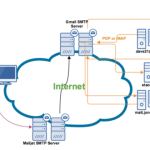CakePHP 4 Email Transport TLS: The Ultimate Guide

Table of Contents
- Introduction
- What is TLS?
- Why Use TLS with Email in CakePHP 4?
- Configuring Email Transport in CakePHP 4
- Troubleshooting Common Issues
- Best Practices for CakePHP 4 Email Transport TLS
- Conclusion
Introduction
Hey there, devs! Are you struggling with setting up email transport in your CakePHP 4 application? Do you want to ensure that your emails are sent securely using TLS? Look no further! In this article, we’ll cover everything you need to know about CakePHP 4 email transport TLS. We’ll dive into the basics of TLS, why it’s essential for email transport, and provide a step-by-step guide on configuring email transport in CakePHP 4. So, grab a cup of coffee, and let’s get started!
What is TLS?
TLS stands for Transport Layer Security, and it’s a cryptographic protocol used to provide secure communication between web servers and clients. In the context of email transport, TLS is used to encrypt the connection between your application and the email server. This ensures that sensitive information, such as authentication credentials and email content, is protected from eavesdropping and tampering.
Why Use TLS with Email in CakePHP 4?
Using TLS with email in CakePHP 4 is crucial for several reasons:
- Security: TLS encrypts the connection between your application and the email server, protecting sensitive information from unauthorized access.
- Compliance: Many organizations require TLS encryption for email communication to ensure compliance with regulatory requirements, such as GDPR and HIPAA.
- Reliability: TLS helps prevent email spoofing and phishing attacks by verifying the identity of the email server.
Configuring Email Transport in CakePHP 4
Configuring email transport in CakePHP 4 is relatively straightforward. Here are the steps:
Using Environment Variables
You can configure email transport using environment variables in your .env file. Here’s an example:
MAIL_TRANSPORT_DEFAULT_HOST=smtp.gmail.com
MAIL_TRANSPORT_DEFAULT_PORT=587
MAIL_TRANSPORT_DEFAULT_TLS=true
MAIL_TRANSPORT_DEFAULT_USERNAME=your_username
MAIL_TRANSPORT_DEFAULT_PASSWORD=your_passwordIn your config/email.php file, you can then use these environment variables to configure the email transport:
'EmailTransport' => [
'default' => [
'host' => env('MAIL_TRANSPORT_DEFAULT_HOST'),
'port' => env('MAIL_TRANSPORT_DEFAULT_PORT'),
'tls' => env('MAIL_TRANSPORT_DEFAULT_TLS'),
'username' => env('MAIL_TRANSPORT_DEFAULT_USERNAME'),
'password' => env('MAIL_TRANSPORT_DEFAULT_PASSWORD'),
],
],Using the EmailTransport Class
Alternatively, you can configure email transport using the EmailTransport class in your config/email.php file:
'EmailTransport' => [
'default' => [
'host' => 'smtp.gmail.com',
'port' => 587,
'tls' => true,
'username' => 'your_username',
'password' => 'your_password',
],
],In both cases, make sure to replace the placeholder values with your actual email server credentials.
Troubleshooting Common Issues
Here are some common issues you may encounter when configuring CakePHP 4 email transport TLS:
- Connection refused: This error usually occurs when the email server is not configured to use TLS or the port number is incorrect.
- Authentication failed: This error typically happens when the username or password is incorrect.
- TLS negotiation failed: This error may occur when the email server does not support TLS or the TLS version is incompatible.
To troubleshoot these issues, check your email server configuration, verify your credentials, and ensure that the email server supports TLS.
Best Practices for CakePHP 4 Email Transport TLS
Here are some best practices to keep in mind when using CakePHP 4 email transport TLS:
- Use a secure email server: Choose an email server that supports TLS encryption and has a good reputation for security.
- Use strong passwords: Use strong, unique passwords for your email server credentials.
- Keep your email server software up-to-date: Regularly update your email server software to ensure you have the latest security patches.
- Monitor your email logs: Regularly check your email logs to detect any suspicious activity.
Conclusion
And there you have it, folks! CakePHP 4 email transport TLS is a powerful feature that can help you send secure emails in your application. By following the steps outlined in this article, you can configure email transport in CakePHP 4 and ensure that your emails are sent securely using TLS. Remember to follow best practices, troubleshoot common issues, and keep your email server software up-to-date. Happy coding!
CakePHP 4 email transport TLS is an essential feature for any application that requires secure email communication. By understanding how to configure and troubleshoot email transport in CakePHP 4, you can ensure that your emails are delivered securely and reliably. Thanks for reading, and we’ll catch you in the next article!
<